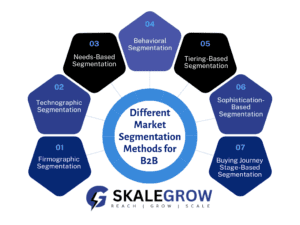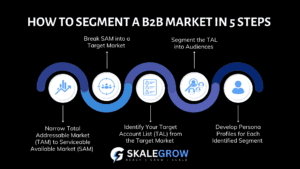With marketing becoming more competitive in the B2B world, targeting the right audience with the right message is crucial. This is where B2B market segmentation, or customer segmentation, comes into play.
B2B market segmentation is the process of dividing a broad business market into distinct subsets of businesses that have common needs, characteristics, or behaviors. It involves categorizing a business market into specific groups or segments based on various criteria. Different segmentation methods are needed for different businesses and marketing goals.
This blog post will delve into seven effective segmentation methods and provide a step-by-step guide on how to segment your B2B market using one or a combination of these methods.
Different Market Segmentation Methods for B2B

B2B markets require a nuanced approach to segmentation compared to B2C. By using a combination of the following methods, B2B companies can create targeted campaigns that resonate with distinct customer segments.
- Firmographic Segmentation: This involves dividing the market based on company attributes. These attributes can include industry, company size, revenue, location, and number of employees . This method helps businesses identify which segments are most likely to need their products or services. For example, a company selling enterprise software might target large corporations with over 500 employees in the tech industry.
- Technographic Segmentation: It categorizes businesses based on their technology stack, including the hardware, software, and other technologies they use. Understanding the technology a company uses can provide insights into their potential needs and readiness for new solutions. For instance, a cloud service provider might target businesses already using cloud-based tools, indicating their openness to adopting more cloud solutions.
- Needs-Based Segmentation: This involves ocusing on the specific needs and pain points of your target customers. The method requires a deep understanding of what drives a company’s purchasing decisions. By identifying and addressing these needs, businesses can offer tailored solutions that directly address the challenges faced by each segment. For example, a logistics company might segment its market based on companies’ needs for faster delivery times or better supply chain management.
- Behavioral Segmentation: Also known as intent-based segmentation, analyzes the behaviors and actions of businesses to determine their stage in the buying process. This includes tracking website visits, content downloads, email engagement, and other interactions. By understanding these behaviors, businesses can identify prospects showing intent to purchase and target them with relevant content.
- Tiering-Based Segmentation: High-tier segments include key accounts or strategic partners, while lower-tier segments include smaller or less critical customers. This method helps prioritize marketing efforts and allocate resources efficiently. For instance, a software company might dedicate more resources to high-value enterprise clients while using automated marketing for smaller businesses.
- Sophistication-Based Segmentation: This method helps tailor marketing messages to different levels of expertise, such as critical decision-makers, end users, industry experts, or different teams like HR, finance, or IT. For example, an HRIT solutions provider might create different content for CIOs (industry experts) and HR managers (end users) to address their unique perspectives and needs.
- Buying Journey Stage-Based Segmentation: The stages typically include Qualified, Aware, Engaged, Marketing Qualified Account (in-market accounts), Opportunity, Customer, and Post-sale. By understanding where a business is in the buying process, marketers can deliver targeted content and experiences that move them closer to a purchase decision. For example, a SaaS company can provide detailed product demos to engaged prospects and case studies to marketing-qualified accounts.
How to Segment a B2B Market in 5 Steps

B2B market segmentation enables you to attract the right kind of customers. By following a structured approach, you ensure you’re casting your net in the right areas and using the most effective bait. This 5-step process will help you with your B2B marketing segmentation, saving time and resources while maximizing your chances of reeling in qualified leads.
Step 1: Narrow Total Addressable Market (TAM) to Serviceable Available Market (SAM)
Begin by identifying your Total Addressable Market (TAM), which includes all potential customers who could benefit from your product or service. Next, narrow this down to your Serviceable Available Market (SAM), which represents the segment of the TAM you can realistically target and serve based on your resources, expertise, and market conditions. This step ensures you focus on a more manageable and relevant market segment.
Step 2: Break SAM into a Target Market
Within your SAM, identify your Target Market, which consists of the most promising segments with the highest potential for success. This involves analyzing firmographic, technographic, and needs-based data to pinpoint which businesses align best with your value proposition. For instance, a cybersecurity company might target mid-sized financial institutions within their SAM due to the high need for security solutions in this sector.
Step 3: Identify Your Target Account List (TAL) from the Target Market
Once you have your Target Market, create a Target Account List (TAL) comprising specific companies you want to engage with. This list should include high-value prospects that match your ideal customer profile. Use firmographic and technographic data to identify these accounts and prioritize them based on their potential value to your business.
Step 4: Segment the TAL into Audiences
Using one or a combination of the seven segmentation methods mentioned earlier, segment your TAL into distinct audiences for B2B audience segmentation. For example, you might use technographic and needs-based B2B segmentation to create segments of companies using specific software solutions and facing certain challenges. This step allows you to tailor your marketing efforts to the unique characteristics of each audience.
Step 5: Develop Persona Profiles for Each Identified Segment
Create detailed persona profiles for each segment, including information about their needs, pain points, decision-making processes, and preferred communication channels. These profiles will guide your content creation and marketing strategies, ensuring that your messages resonate with each segment.
Conclusion
B2B market segmentation is a powerful tool that enables businesses to target their marketing efforts more effectively. By understanding and analyzing different market segments, you can tailor your approach to meet the unique needs of each segment, resulting in higher engagement and conversion rates. Following a step-by-step process to segment your market ensures that you focus on the most promising opportunities and create targeted marketing campaigns that resonate with your audience.
At Skalegrow, we specialize in helping B2B businesses navigate the complexities of marketing and growth. Our expert team leverages several years of experience to analyze your market, identify key segments, and develop personalized marketing campaigns that drive results.
Contact Skalegrow today to elevate your B2B marketing efforts!


